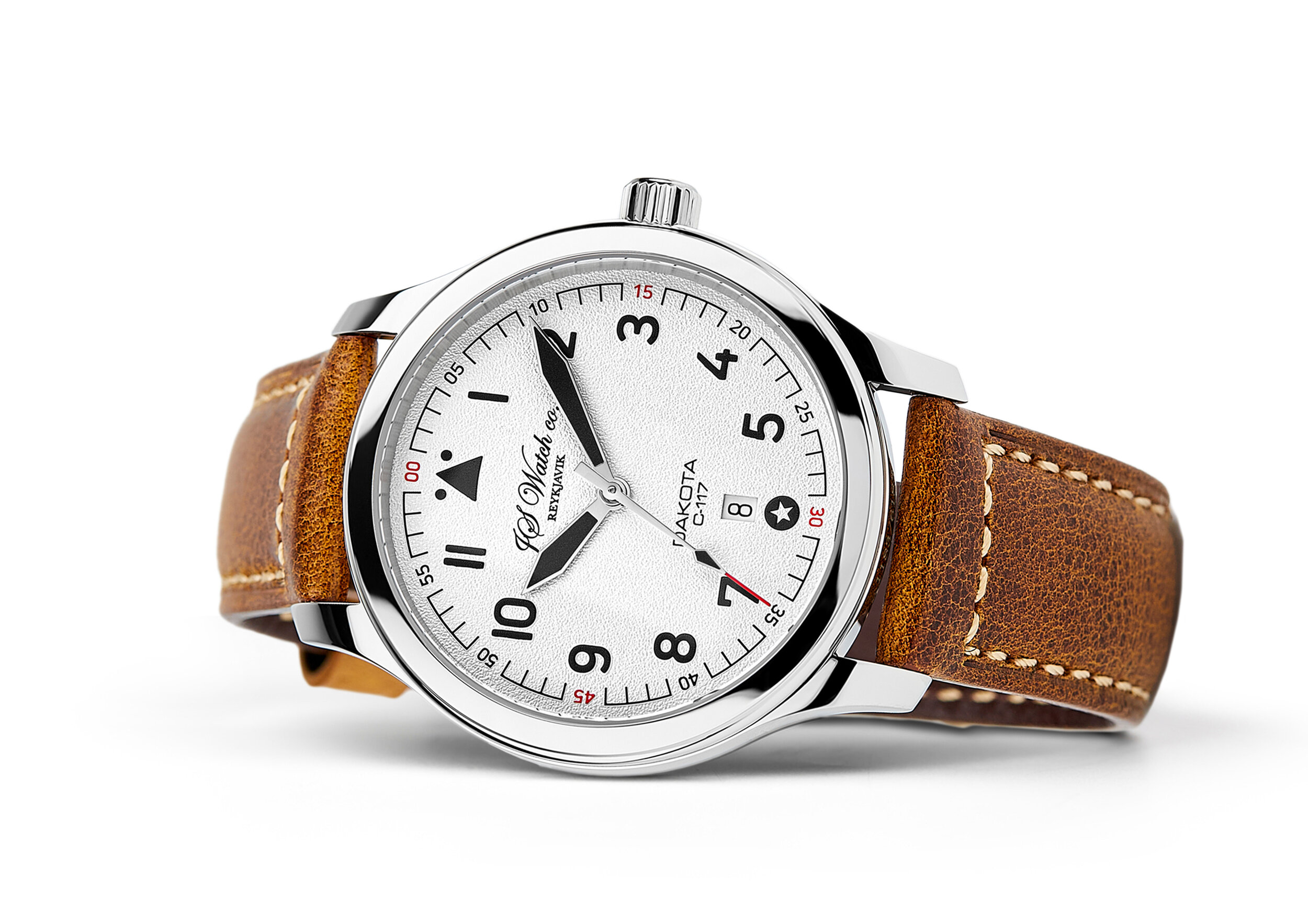
Islandus Dakota
Discover the Islandus Dakota Pilot style watch, available in a 44 mm steel case with with black or white dials, rhodium plated luminous hands and Italian Calf leather strap or Steel bracelet.
Any landing you can walk away from is a good landing!
Collection Islandus Dakota 44mm
The Islandus Dakota collection is available in a 44 mm steel case with with black or silver dial with luminous numerals,
Rhodium plated luminous hands and Italian Calf leather strap or Steel bracelet. Date display is located at 6 o'clock. Swiss Made Mechanical movement “Execution Top” with Automatic winding, 25 jewels, Custom decorations, Blue screws and Rhodium plated finish, which can be examined in detail through a sapphire crystal case back. All decorations and craftsmanship is of the highest quality.
Technical specifications
Movement
Swiss Made Mechanical movement “Execution Top”
Automatic winding
25 jewels, Custom decorations, Blue screws and Rhodium plated finish.
42-hour power reserve when fully wound.
Fine tuning: “Assortment Chronometer”.
Shock protection: Incabloc.
Adjusted to five positions.
Case
Material: Surgical grade German Stainless Steel "316L"
Diameter: 44mm, height 11.5mm.
Surface finish: Highly polished.
Curved Sapphire Crystal with multi anti reflective coating on the inside.
See-through Sapphire Crystal display back.
Lug width: 22mm
Lug to Lug length: 53mm
Dial
Black grain finish / Silver grain finish, with Arabic numerals in black or old radium Super-LumiNova
Date display at six o'clock.
Hands
Rhodium plated with black Super-LumiNova / Matt black with old radium Super-LumiNova.
Strap
Handmade 22mm black or brown Italian Calf with JS Watch co. Reykjavik buckle or optional deployant clasp.
Steel bracelet also available.
Inspiration
In our design, we draw inspiration from classic watches and the history connected to Iceland. So, when we decided to design and introduce a new Pilot watch to our collection, we conducted thorough research into Icelandic aviation history. It wasn't hard to choose a worthy and dramatic story to be inspired by: the world’s most famous DC-3 Dakota wreck, sitting atop its grave in the post-apocalyptic surroundings of the vast black sand (Sólheimasandur) on the southern coast of Iceland.
On the 21st of November 1973, the day before Thanksgiving, the Navy plane Douglas Dakota C-117 (serial number 17171) was flown by Captain James Wicke on a routine mission to the east part of Iceland. The weather turned for the worst, and the temperature plunged to -10°C. The wind gust increased to 96 km/h (60 mph), and the carburetor started sucking in ice. As the weather force increased, the fight with heavy turbulence was lost, and both engines froze solid and stopped spinning. Wrapped in heavy fog, the five passengers had no clue as to their location, as they could not even see the tip of the wings when they looked out the window, fearing the worst: that they were going to crash into a mountain and die.
As the plane was falling over Vatnajökull glacier, Captain Wicke put out a mayday and tried to restart the engines. The mayday signal was picked up by another air force plane, and immediately 3 Phantom air jets and 2 helicopters were airborne. All ships sailing on the south coast of Iceland were notified, as it was not known exactly where the plane would land. A daring decision was made by Lieutenant Gregory Fletcher, a 26-year-old pilot in training who had only flown 21 hours in a C-117. Fletcher, knowing that a crash into the mountains would kill him and his passengers, opted for the lesser of a few bad choices. He decided to try his luck and land on the ocean, giving them a slightly better chance to survive, as one might possibly live for more than 15 seconds in the cold Atlantic Ocean, even though hypothermia would set in quickly. Crashing into the ice cap of Europe's largest glacier would mean certain death. As the plane kept losing altitude, reaching the coastline, Fletcher realized they were gliding over 'some goddamn thing that looked like the moon.' He managed to get the plane parallel to the shoreline and used the frozen black sand beach as a bumpy runway. Skidding some 27 meters (90 feet) over the sand dune, bending the propellers, crushing the engine cover, and rupturing the tanks, Fletcher stopped the plane 6 meters (20 feet) from the ocean, saving everyone’s life. 'Smoothest landing I’ve ever been a part of,' said Howard Rowley, an Air Force Master Sergeant.
The survivors were airlifted away by the Air Force search helicopter, just an hour after the crash. Later on, back at the Keflavík military base, those involved were found to have survived without any injuries, not even a scratch. However, the same could not be said about the plane itself. The US Navy dismantled the most important parts and left the rest to its fate, and two days after the crash, the fuselage was like a skeleton in the black apocalyptic desert. That was over 40 years ago now.
For a long time, the Dakota crash site was considered a hidden secret among photography enthusiasts and lay largely unnoticed in the sand. The documentary film 'Heima' by the Icelandic rock band Sigur Rós in 2007 raised public awareness, and then later, when Justin Bieber skateboarded on the roof in his music video for 'I’ll Show You' (2015), the plane wreck became known far beyond the country’s borders.





















